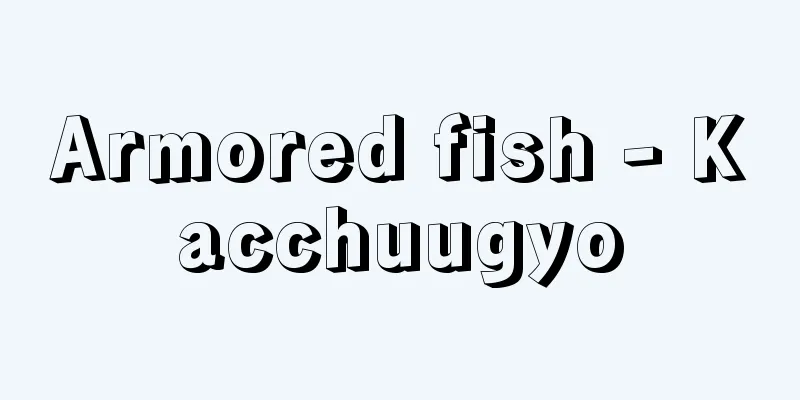Armored fish - Kacchuugyo

|
A general name for Paleozoic fishes that have a hard, thick exoskeleton. It is not a formal taxonomic name. Many jawless fishes fall into this category. Placoderms are also sometimes called armored fish because they have a hard exoskeleton. [Yoshitaka Yabumoto] AgnathidsSome species of jawless fish can reach 1.5 metres in length, but most are small fish measuring around 15 centimetres. They lack jaws, with their mouths merely small holes or transverse slits. They lack the paired fins typically found in aquatic vertebrates. They have one or two semicircular canals. Their gills are attached to the inside of their visceral skeletal system. They have many gill arches, the anterior of which were thought to have evolved into the jaws of later fish, but this idea is now rejected. The skull is fused to the gill arches. The jawless fish are broadly divided into the hagfish, pteraspids, and cephalaspids. The most primitive are the hagfish, whose fossils have been discovered since the Carboniferous Period. The pteraspids, discovered from the middle Ordovician to the late Devonian, and the cephalaspids, discovered from the late Silurian to the Devonian, have hard exoskeletons. Most of them disappeared towards the end of the Devonian, but the lampreys, thought to belong to the hagfish and cephalaspid groups, do not have exoskeletons and have survived to the present day by acquiring a special lifestyle, such as parasitizing other animals; these are sometimes collectively referred to as cyclostomes. [Yoshitaka Yabumoto] PlacodermsPlacoderms, which appeared in the early Silurian period, also had a hard exoskeleton, but were distinguished from the Agnatha by having jaws. Placoderms had a skull that was hinged to the carapace. Both jaws had no teeth, but the jawbone had sharp teeth at the joints that served as teeth. Placoderms flourished most in the Devonian period, and a wide variety of species appeared. There are several groups known, including the Coccosteidae (articulates) discovered from the early Devonian to early Carboniferous periods, the Ptictoduidae (mid-Devonian to early Carboniferous periods), and the Asterolepis (carapaces) discovered from the early Devonian to early Carboniferous periods, but all of them became extinct by the early Carboniferous period. Placoderms, like Agnatha, were originally marine, but many of them moved into freshwater during the Devonian period. [Yoshitaka Yabumoto] EcologySome of these so-called armored fishes, with their hard exoskeletons, such as a certain group of placoderms (Dunkleosteus of the Arthropods), swam through the water and became powerful predators with their strong jaws. However, most of the so-called armored fishes were small, weak creatures that lived on the bottom of the water. At the same time, large predators called eustoptera (sea scorpions) lived in the water. It is thought that the exoskeleton of armored fish was a way to protect them from these eustoptera. Armored fish flourished during the early to middle Devonian period, but by the end of the Devonian period they were replaced by cartilaginous and bony fishes, which had advanced jaws, lighter bodies, stronger internal skeletons, and paired fins that enabled them to swim freely in the water, and most of them went into extinction or declined. [Yoshitaka Yabumoto] [References] | | | | | | | |Devonian period of the Paleozoic Era: Photos from Britain / Fukui Prefectural Dinosaur Museum Image Library "> Coccosteus cuspidatus sp. Late Devonian period of the Paleozoic Era, Morocco Photo/Fukui Prefectural Dinosaur Museum Image Library "> Dunkleosteus skull Source: Shogakukan Encyclopedia Nipponica About Encyclopedia Nipponica Information | Legend |
|
古生代の魚類のなかで、硬くて厚い外骨格をもつものに対する一般的名称。分類学上の正式な名称ではない。多くの無顎(むがく)類がこれにあたる。また、板皮(ばんぴ)類も硬い外骨格をもつことから甲冑魚とよばれることがある。 [籔本美孝] 無顎類無顎類は全長1.5メートルに達する種類もあるが、ほとんどのものが15センチメートル内外の小形の魚である。あごがなく、口は単なる小孔か横裂にすぎない。水生脊椎(せきつい)動物に典型的にみられる対鰭(ついき)(ひれ)がない。半規管(はんきかん)は1ないし2本。えらは内臓骨格系の内側についている。多くの鰓弓(さいきゅう)があり、その前方のものが後の魚類のあごに変化したと考えられていたが、現在ではこの考えは否定的である。頭骨は鰓弓と癒着している。 無顎類はヌタウナギ類、プテラスピス類、ケファラスピス類に大きく分けられる。もっとも原始的なものはヌタウナギ類で、化石は石炭紀から発見されている。オルドビス紀中期からデボン紀後期にかけて発見されているプテラスピス類、シルル紀後期からデボン紀にかけて発見されているケファラスピス類などが硬い外骨格を有する。デボン紀の終わりごろにはほとんどのものが姿を消しているが、ヌタウナギ類とケファラスピス類に属すると考えられるヤツメウナギ類は外骨格をもたず、ほかの動物への寄生など特殊な生活様式を獲得したことによって現在も生き残っており、これらは円口類と総称されることもある。 [籔本美孝] 板皮類シルル紀初期に出現した板皮類も硬い外骨格をもっていたが、あごがある点で無顎類から区別される。板皮類は頭甲(とうこう)をもち、頭甲は胴甲(どうこう)と蝶番(ちょうつがい)式に関接している。両顎(りょうがく)に歯はないが、顎骨(がくこつ)のかみ合わせの部分が鋭く、歯の役目をしていた。板皮類はデボン紀にもっとも栄え、多種多様な種類が現れた。デボン紀初期から石炭紀初期にかけて発見されているコッコステウス類(節頸(せっけい)類)、デボン紀中期から石炭紀初期にかけて発見されているプティクトダス類、デボン紀初期から石炭紀初期にかけて発見されているアステロレピス類(胴甲類)などいくつかのグループが知られているが、いずれも石炭紀初期には絶滅している。板皮類は無顎類同様本来は海水性であったが、デボン紀の間に多くのものが淡水へ侵出していった。 [籔本美孝] 生態これら硬い外骨格をもつ、いわゆる甲冑魚のなかには、板皮類のある一群(節頸類のダンクルオステウス)のように水中を泳ぎ回り、強いあごで強力な捕食者となったものもいる。しかし、甲冑魚とよばれるほとんどのものは水底で生活する小形の弱い生き物であった。同時代の水中には大形の捕食者である広翼(こうよく)類(ウミサソリ)がすんでいた。甲冑魚の外骨格は、これら広翼類から身を守るためのものであったと考えられている。 甲冑魚はデボン紀前期から中期にかけて大いに繁栄したが、デボン紀の終わりごろには、進歩したあごと軽い体、より強い内骨格、そして水中を自由に泳ぎ回ることのできる対鰭をもった軟骨魚類や硬骨魚類にとってかわられ、ほとんどのものが絶滅または衰退の一途を歩んでいる。 [籔本美孝] [参照項目] | | | | | | | |古生代デボン紀 イギリス産写真/福井県立恐竜博物館画像ライブラリー"> コッコステウス・カスピダトス sp. 古生代デボン紀後期 モロッコ産写真/福井県立恐竜博物館画像ライブラリー"> ダンクルオステウスの頭骨 出典 小学館 日本大百科全書(ニッポニカ)日本大百科全書(ニッポニカ)について 情報 | 凡例 |
Recommend
Chemo synthesis
... The ammonia thus produced is oxidized to NO 2...
Column - Eiren
A couplet on the Bo Zhu. A couplet. A Bo Chronicle...
Tsukushi Koto - Tsukushigoto
The name of a genre of Japanese music and the inst...
Cycas revoluta - Cycas revoluta
An evergreen fern of the Dryopteris family. It ha...
Exclamation mark
… Punctuation is the equivalent of punctuation in...
Dutch Trading Post Diary - Holland Trading Post Diary
These are official diaries written by successive ...
Wu Yu-zhang (English name)
Born: Guangxu 4 (1878). December 30, 1878. Sichuan...
Fujinami family
A nobleman of the direct line of Onakatomi Kiyomar...
Kasai Corridor - Kasai Corridor
The oasis area west of the Yellow River in Gansu P...
Toribio de Benavente Motolinía (English spelling)
1482 to 91-1569? A Spanish Franciscan friar, he tr...
Lufthansa German Airlines [company] - Lufthansa Germany Airlines (English name) Deutsche Lufthansa AG
German airline. Airline code: LH. Headquarters: Co...
Stapelia - Stapelia
A general term for the genus Stapelia in the fami...
Kosaku Yamada
Year of death: December 29, 1965 Year of birth: Ju...
Fjalarr
…Kvasir traveled the wide world, imparting wisdom...
Hypobulia
...When this abnormally increases and one act aft...









